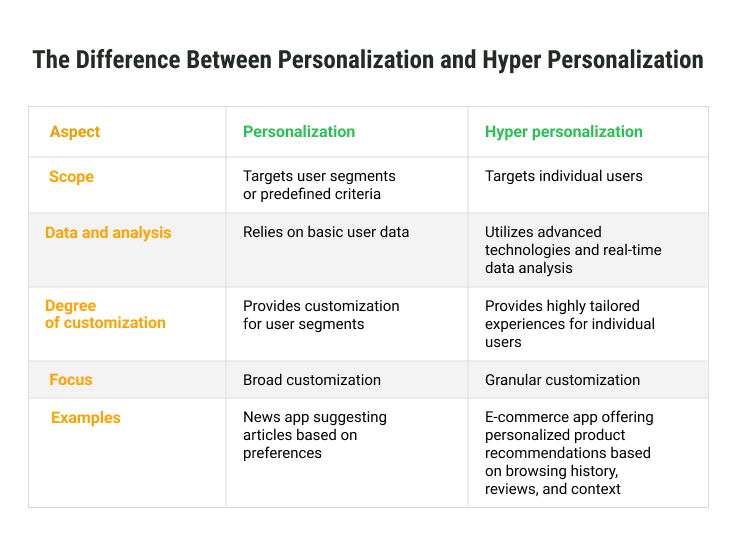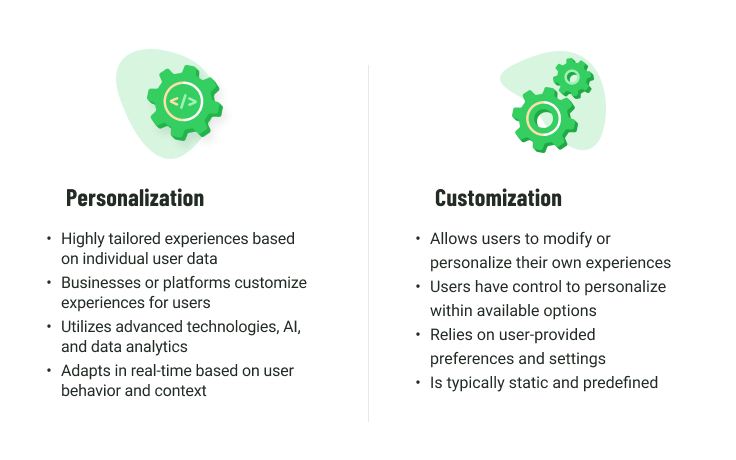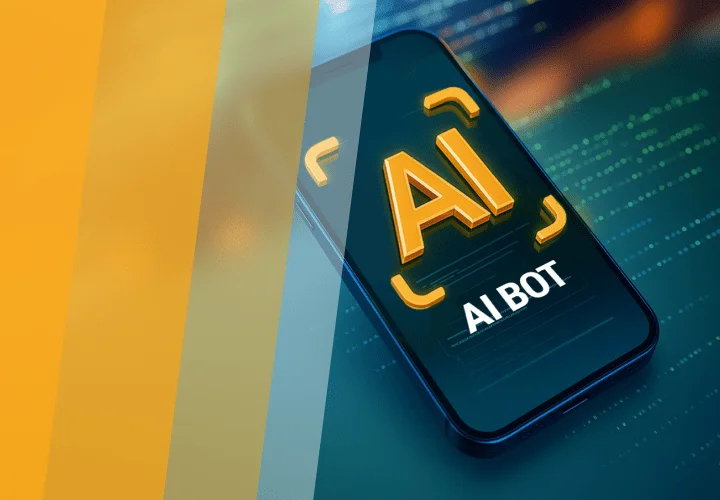Is App Hyper Personalization a New Thing in Product Development?
Table of contents
The ever-progressing digitalization of the economy and society is unlocking new opportunities for organizations engaging in service provision. We are in the middle of a transformation of the service sector, where recent advances and developments in technologies such as AI, Extended Reality, Blockchain, and more are empowering businesses to thrive in this technological era. In this landscape, achieving unparalleled personalization has become a strategic goal for companies seeking to differentiate themselves and retain customers.
However, the pursuit of even greater personalization has given rise to a new paradigm: hyper personalization. In this article, tapping into Emerline's expertise, we will explore the concept of hyper personalization, its distinctions from traditional personalization, and the methods to achieve it.
What Is App Hyper Personalization?
Hyper personalization refers to a streamlined, adaptive, and scalable approach that aims to target, create, and provide personalized service encounters tailored for individual users, driven by specific criteria. It is grounded in the underlying megatrend of the digitalization of business operations across industries.
Mobile app hyper personalization refers to customizing mobile applications based on individual user preferences and behaviors using advanced technologies like AI and data analytics. It involves collecting user data to create personalized profiles and deliver tailored content, recommendations, and notifications, enhancing the user experience.
Although hyper personalization can be seen as an evolution or an advanced form of personalization and that both phenomena share the same final goal, there are some differences between them. Let’s take a closer look to see what these differences are.
Personalization vs Hyper Personalization
By recognizing the importance of tailoring experiences to individual users, personalization laid the foundation for hyper personalization. As technology and data analytics capabilities advanced, hyper personalization emerged as a more sophisticated approach to customization.
While personalization typically revolves around basic data such as a customer's name, gender, and general location, hyper-personalization takes customization to a deeper level. By leveraging extensive and detailed information, hyper-personalization paints a comprehensive picture of a customer's interests, behaviors, and individual needs, enabling a truly tailored experience.
Apart from this fundamental distinction, there exists a range of other differentiating factors to explore.

While many people may think that hyper personalization is similar to customization, it’s important to note that there are significant differences between personalization and customization as well.

However, despite their differences, customization and personalization also share some commonalities in enhancing the user experience.
- Both approaches prioritize the user's needs and preferences, aiming to create tailored experiences that are relevant and meaningful.
- Both approaches increase user engagement by providing options for customization or delivering personalized content.
- Both approaches offer users a sense of control and flexibility, allowing them to shape their experience according to their preferences.
- Ultimately, both personalization and customization contribute to higher user satisfaction and a more personalized user experience.
Why Are Users Looking for Even Greater Personalization in Apps?
According to Google, 63% of smartphone users are more likely to purchase from companies whose mobile sites or apps offer them relevant recommendations on products they may be interested in.
Indeed, users across various domains, especially E-commerce, are actively seeking even greater personalization in mobile apps that cater to their specific interests. Here are just some of the reasons why:
Relevance
Users crave personalized recommendations and experiences that align with their specific preferences. By providing relevant product suggestions and recommendations based on users' browsing and purchase history, personalized mobile apps make it easier for shoppers to discover and engage with products that cater to their individual tastes and preferences.
Engagement and satisfaction
Personalization in mobile apps enhances user engagement and satisfaction by delivering customized features and interactions. Personalized experiences create a sense of being valued as users receive tailored content and recommendations.
For instance, personalized notifications, exclusive offers, or rewards based on user behavior can keep shoppers engaged and encourage them to revisit the app for future purchases. This results in increased user satisfaction, as users feel that the app understands their needs and caters to their preferences.
Sense of loyalty
Greater personalization fosters a sense of connection and loyalty between users and apps. When an app understands and anticipates user needs, it creates a unique and personalized bond, making users feel valued and understood. This emotional connection leads to increased user satisfaction and a higher likelihood of continued app usage.
Overall, personalized apps that cater to user-specific interests not only make clients happy but also bring numerous benefits to businesses. Happy clients translate into higher return rates, increased turnover, enhanced customer loyalty, and ultimately, greater revenue and competitive advantages. This can be demonstrated by the following statistics:
- According to Google, 89% of U.S. marketers reported that personalization on their websites or apps resulted in increased revenue.
- 58% of smartphone users feel more favorable toward companies whose mobile sites or apps remember who they are and their past behavior.
- Smart personalization engines used to recognize customer intent will enable digital businesses to increase their profits by up to 15%.
- 80% of consumers are more likely to make a purchase when brands offer personalized experiences.
These statistics clearly demonstrate the strong correlation between company success and personalization, highlighting the immense potential that hyper-personalized apps hold in achieving even greater results. At the same time, the number of companies that have started their hyper personalization introduction strategy is relatively low, according to Ascend2 research.

How To Achieve Hyper Personalization in Apps?
One of the primary reasons for this low adoption rate is the limited understanding and knowledge of how to effectively implement and embrace hyper personalization within their digital platforms. Here are some steps that can help you ensure your app is hyper personalized.
The first step to improving customer experience with hyper-personalization is understanding your customers on a deeper level. This goes beyond basic demographics and requires gathering and analyzing behavioral, psychographic, geographic, and demographic data. By leveraging first- and third-party data sources, organizations can gain insights into customer preferences and enhance personalization efforts. Effective data management solutions also play a crucial role in this process.
Then, evaluate your company’s data and technology. Determine the necessary data sources and technical capabilities required for effective personalization implementation.
The third step is to create a strategic roadmap that outlines the personalization elements to be implemented, their timing, and the approach for integration. Consider multiple elements of the business and ensure alignment with the organization's goals.
And don’t forget about the essential features developed using cutting-edge technologies. Here is a list of examples of how you can achieve hyper personalization of your app:

Let's explore some concrete examples of hyper personalization in different industries:
- If you develop your business in the healthcare/wellness industry, you can leverage the power of personalized nutrition apps, which create tailored meal plans based on individual dietary restrictions, health goals, and nutritional needs.
- If you run an E-commerce platform, employing customized email campaigns can greatly impact customer engagement. These campaigns deliver targeted offers and promotions, meticulously curated to align with a customer’s shopping behavior and interests.
- In the E-learning realm, incorporating personalized learning paths into your app can revolutionize the educational journey. By recommending specific courses or modules based on a learner’s unique interests, skills, and career goals, you can provide a highly customized and adaptive learning experience.
Conclusion
Hyper personalization has become a crucial need in today's competitive landscape, offering businesses numerous advantages. By tailoring app experiences to individual users, companies can enhance customer satisfaction, increase engagement, and gain a competitive edge.
Want to create a hyper personalized app from scratch or enhance your existing app with personalized features? At Emerline, we provide comprehensive services to help you achieve your goals, from custom end-to-end product development to UX research and design. To ensure your app delivers a truly personalized experience, we leverage cutting-edge technologies and industry best practices.
Book a free consultation with our experts and let us guide you on your journey towards hyper personalization. Together, we can create an app that not only meets your expectations but exceeds the expectations of both you and your users.
Published on Jul 13, 2023





